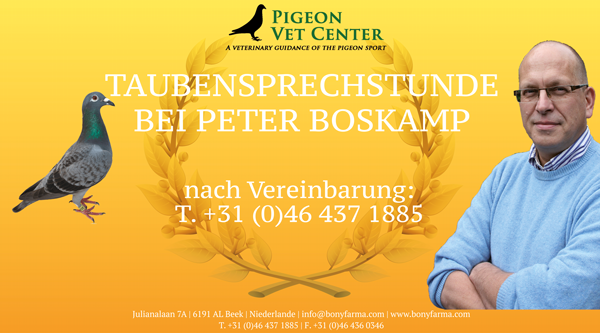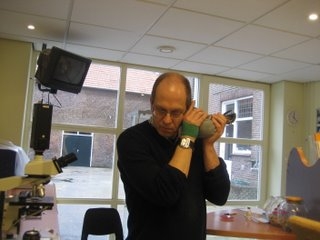Up-to-date on the young animal trip 2023..
The Ornithose-Koplexes
Respiratory diseases, together with the adeno-coli complex, form the greatest threat to pigeon health during the young pigeon racing season.
Strong eruption from ornithosis Koplexes can destroy all illusions within a short time. In respiratory diseases can be made between various diseases and triggers the symptoms. In theory, this aspect is interesting, but for a practical approach to the problem, it is better from “Ornithose-Komplex” to speak.
Under the ornithosis complex in pigeons, we mean a combination of diseases of the anterior airways and heads for (young) pigeons. Pure infections by certain pathogens there is certainly, but mostly it is a combination of one or more pathogens other factors that are causing the problems.
In this combination I will discuss in more detail later.
Causes and Symptoms
In the case of infections of the respiratory tract in pigeons, a large number of pathogens must be distinguished. Many pathogens cause similar disease symptoms. We can distinguish viral, bacterial, protozoal and infections with mycoplasma and chlamydia.
Most of the time we observe the well-known symptoms of the front airways in variation with wet eyes, pricked ears, wheezing, frequent sneezing, coughing with slight pressure on the trachea, scratching the ears and rubbing the eyes on the feathers.
Frequent yawning and, of course, mucus in the throat can also indicate the respiratory tract. So there is a whole gamut of symptoms that point to respiratory infections. Sometimes a number of these symptoms are quite specific to a pathogen, e.g. inflammation of an eye is often referred to as pure ornithosis secondary to Chlamydia infection. In the case of diffuse coatings on the throat and trachea, it is usually a herpes infection. In most cases, however, the symptoms point to a number of possible pathogens.
Therefore detailed tests to determine the cause are in demand.
examination
Some culprits can be identified by swabs of the eyes and/or the excreta, which are stained. In other cases, a bacteriological examination is a way out. You have to wait a few days for the result. Even with dissections, the result is only known after a few days, since a bacterial examination has to take place here too. The detection of trichomoniasis (yellow button) through throat swabs is also important in this context. In practice, pigeons with a trichomoniasis infection are much more sensitive to other respiratory diseases.
Combination of factors
As said, the symptoms in pigeons are in some cases very characteristic. As it can happen, for example, with an infection with herpes, but does not have to happen. Because a herpes infection is not always the cause of visible symptoms. It has been shown that 60% of the pigeons “serologically positive” responded to antibodies against the herpes virus. This means that 60% of the pigeons came into contact with the virus and formed antibodies against it. By no means all pigeons become ill as a result of the infection.
The same applies to infection with Chlamydiae. More than 50% of the pigeons have antibodies against it in the blood. Here too, many pigeons are infected without becoming ill. This also applies to other respiratory pathogens such as mycoplasma and staphylococci.
Even the viruses that appear in young pigeons at the age of 1.5 to 2 months do not always cause clinical diseases. So we can assume that many pigeons carry pathogens without getting sick. Whether a disease breaks out or not depends on several factors. I would like to name a few here. If many pigeons are kept in a small space, so you can speak of overcrowding, pigeons are more likely to get sick than if a few pigeons are kept in the loft.
The stress of overcrowding makes pigeons more sensitive to those pathogens that are latently present. This also applies to transport. The pigeons then sit close together. In addition, transport in itself is unnatural and thus causes stress. In addition to stress from overpopulation and other causes, the intensity of the pathogen is of course also important. Stronger pathogens are more likely to trigger disease symptoms than milder variants.
Therefore, if drugs are to be administered to combat these pathogens, it is important to administer them in sufficiently high doses and for a sufficiently long time. (Some medicines on the market contain at most 5 active substances. The risk of underdosing is more than likely when using these medicines.) Another important factor in the onset of an illness is the conditions in the loft. It is known in this regard that the loft should be dry, warm and draft-free. Draft is fatal for pigeons and influences the outbreak of a disease significantly. Moisture in the loft contributes to mold growth. Molds, in turn, weaken the pigeons' defences. So there are several factors responsible for whether diseases break out among the pigeons or not. The most important factor in whether a pigeon gets sick or not is its own defenses. This factor is often neglected.
Every pigeon fancier should ensure that his pigeons have the highest possible defense. Pigeons with higher defenses are less susceptible to all other factors that play a role in the onset of clinical respiratory infections. That's why you should make sure that young pigeons grow up with as strong a defense as possible. During the racing season, this prevents young pigeons from developing symptoms of illness at the slightest risk of infection. Many pigeon fanciers try to compensate for a lack of defense by using medication. Although nowadays it is difficult to practice pigeon racing completely without medication, it would be good to limit their use. In order to achieve that, one should rather provide.
The basis for this should already be laid during breeding. If one considers that more than 50% of the pigeons are carriers of chlamidia, it is clear that there is a risk that the young pigeons are infected with these parasites already in the nest. If you ensure an optimal course of breeding, you reduce the risk of the young being infected at a very early age.
The same is true of course for rearing. Youngsters need to build up their defenses the “Children's diseases” durchmachen. Wichtig ist dabei, daß sie gut genug dafür ausgerüstet sind, d.h. daß ihre Abwehr stark genug sein muß. Wenn wir schon in der Aufzucht der Jungen viele Medikamente einsetzen müssen, ist dies bestimmt keine Garantie dafür, gute, leistungsfähige Jungen zu bekommen.
preventive action
It is extremely important to take precautionary measures so that the pigeons develop better defenses and therefore need less medication to fight diseases that break through their own defences. The need to cure during a playing season often spells the end of benefits.
In recent years we have delved into the preventive improvement of the defense. It has been proven that our defense drink contributes to a better defense. We have tried to further develop this defensive drink through research and think we have succeeded. It has been shown that the breeding animals develop a better condition through regular use of the defense drink.
Aber auch die Jungen wachsen besser auf, bekommen ein besseres Federwerk und sind weniger empfindlich für Kinderkrankheiten. Das Abwehrgetränk hilft durch seine versäuernde Wirkung auch präventiv gegen den Adenocoli-Komplex, eine andere Krankheit, die junge Tauben treffen kann. Wie beim Ornithose-Komplex handelt es sich um eine Krankheit, deren Ernsthaftigkeit von mehreren Faktoren abhängt.
Wir empfehlen, während der Zucht und Aufzucht regelmäßig natürliche abwehrstärkende Mittel einzusetzen, um jungen Tauben auf eine natürliche Weise mehr Abwehr gegen Krankheitserreger zu verschaffen. Gelegentliche Verabreichung dieser abwehrstärkenden Mittel ist nicht ausreichend. Man muß sie regelmäßig verabreichen, wenn sie effektiv sein sollen. Dann bringen sie aber auch Resultate.
A warning must be given, however. Since the pigeons grow up faster by using the repellent drink, there is a risk that they will be in shape too early. You should pay attention to this. That is why we recommend not administering the defense drink more than three days a week after weaning. As the flying season approaches, use of the drink can be increased to 5 days per week. The defense drink must not be combined with medication in the drinking container. If drugs are already being used, they should best be administered via the feed.
Treatment
In the event of a clinical outbreak of ornithosis, a number of medications are available. Pigeons can also be treated individually with Ornithosis capsules, one capsule per pigeon per day. Depending on the severity of the disease, it is possible to treat the patient with powder 18, SA-Mix, powder 26, powder 31 and powder 27 via drinking water or food. Powder 18 and SA-Mix are also effective against trichomoniasis and hexamitiasis. In the case of chronic infections, powder 26 (Myco-Orni-Mix), powder 27 (Tylodox plus), powder 31 (SES-V) and Orni-P can be used. In the case of serious infections, in the case of failures during the flights, it is prudent to keep the pigeons at home for a week to prevent heavy losses during the flights.
Good luck!


Buy BONYFARMA products here…(click)
Pigeonvetcenter
The pigeon clinic Beek is part of the local veterinary center. 6 veterinarians and 8 (paraveterinary) assistants work here. In addition to the use of regular medication, the use of alternative veterinary medicine (e.g. herbs) is of great importance.
We strive in practice through regular preventive health checks to forestall excessive use of drugs. The application of immune strengthening herbs is used with the same goal. Above methods are combined with preventive vaccinations, sure that the pigeons with increased defense can start in the season.
In this way can be scooped during the season also unnecessary treatments, so that time and space to improve the shape of animals and thus to higher performance occur.

Several times per year we send information for pigeon lovers, as well as an overview of drugs frequently used in Pigeon racing to all pigeon fanciers, registered with us. On request, we will send information about new developments, new products and other information relevant to the pigeon sport also regularly by E-Mail.
"Regular health check of the pigeons is the basis for good flight performance"
Pigeonvetcenter
We offer:
- Control of your pigeons and veterinärmedizinische support
- Parasitological examination (including Coccidiosis, worms, etc.)
- Bacteriological examination (including salmonella, E. coli, etc.)
- Viral investigation (including Paramixo, adeno etc.)
- Goiter smear and Cloaca dash
- Vaccinations (u.a paratyphoid, smallpox, Paramixo)
- Mushroom study
- Blood tests
- Fertility treatment
- Operations
- Autopsien
- Intake and observation
- Faecal samples investigation; samples can also be sent to
- X-RAY DIAGNOSTICS
If you want to consult our clinic for examinations, we recommend prior appointment. Then we can take plenty of time for a perfect accompaniment and respond best to the problems.
For veterinary assistance in the pigeon sport
Office hours:
We have three daily office hours from Monday to Friday:
09:00 09:30
13:00 13:30
17:00 – 18:00
On Saturdays we have consultation by:
11:00 12:00
Consultations veterinarian Peter Boskamp:
Nur nach Terminvereinbarung. Um einen Termin zu machen, müssen Sie uns zu kontaktieren.
Outside of these office hours, you can always visit us by appointment.
From March 1 to September 1 we have an additional consultation for vaccinations from 11: 30 to 12:00.
EMERGENCY SERVICES
We are24 hours a day, 7 days a weekavailable for emergencies.




